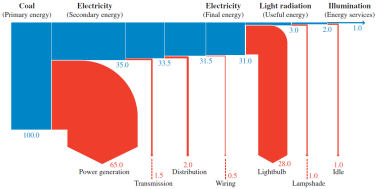Regarding nuclear fuel, there has been huge controversy in public whether it is a solution to our increasing demand for energy. However, before discussing about the advantages and disadvantages of nuclear fuel, we first have to learn how it works.
Nuclear fuel works very like a thermal power station, but the way it heats the water is different from the other sources. First of all, enriched uranium is required to make up the fuel. Enriched fuel contains 3% U-235 and 97% U-238 which has higher percentage of U-235 than the natural uranium. Higher percentage of U-235 is needed for the fuel rod since U-235 is a good absorber of neutrons which is significant for the nuclear fission reaction in vessel.
Nuclear fission is described as:
Using mass deficit and E=mc^2, it is found out that about 200MeV or 3×10^-11J is released in the form of kinetic energy per fission. These fast neutrons with high kinetic energy now turn into thermal neutrons which heats the water. After that, it follows the same process as thermal power station except that reactor vessel has to be in closed-system. This is because turbine steam cannot directly flow into the reactor vessel since there is a probability of leakage of radioactive material to outside of the reactor vessel.
Now, we will learn the functions of some major instruments in nuclear reactor.
Moderator: The function of moderator is to moderate the speeds of the neutrons. Some of the most effective moderators are water and carbon in the form of graphite. When high speed neutrons inelastically collide with the moderator, there is transfer of energy to the atoms of moderator. Moderator is important because it lets neutrons to lose enough kinetic energy so that they can move at the thermal speeds and also have high chance cause further fission.

Control rod: The function of control rod is to control the rate of nuclear fission by absorbing the neutrons. These rods are often made of boron or other elements that absorb neutron very well. Absorbing neutron controls the rate of nuclear fission because it can slow down the rate of chain reaction. Chain reaction is caused by neutrons in the product of nuclear fission. Control rod is important because if it doesn’t control the rate of reaction, then the fuel rods can be overheated and melt. This is very dangerous since it leads to nuclear radiation disaster.
Chain reaction is shown below:








